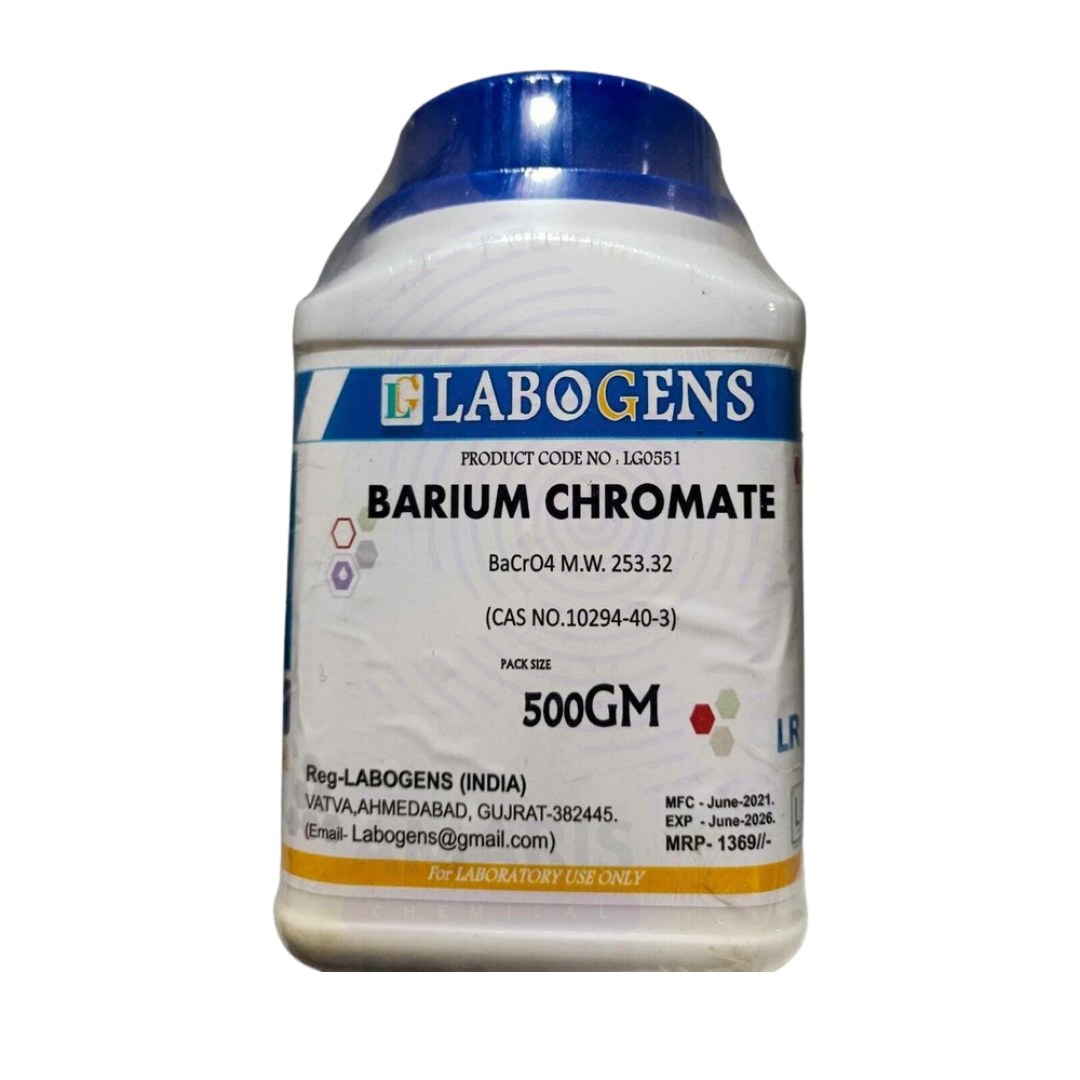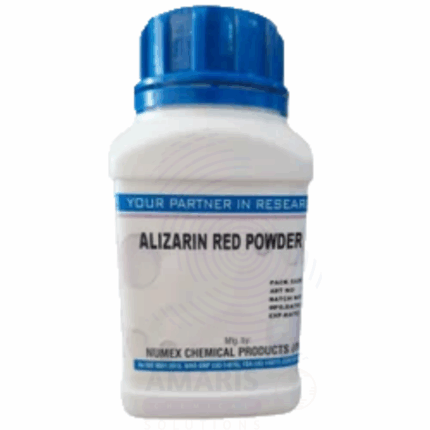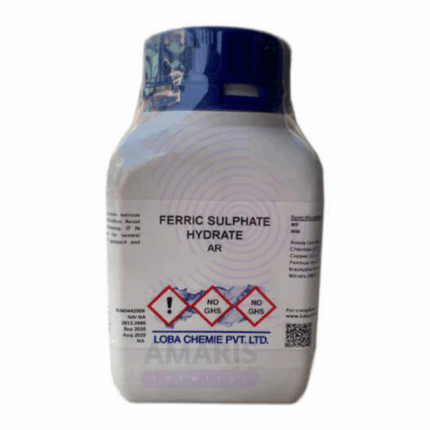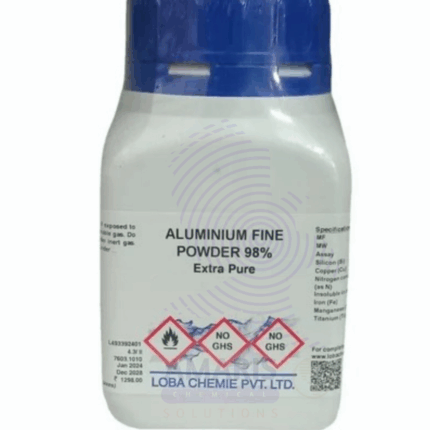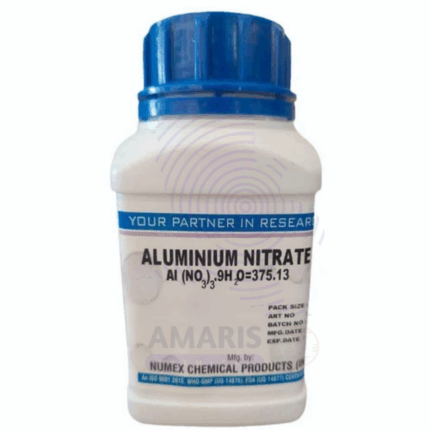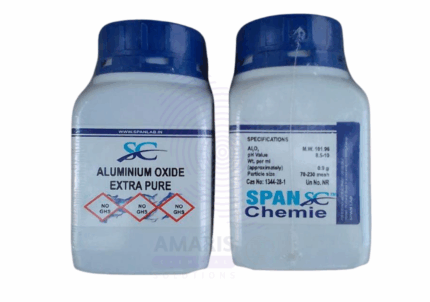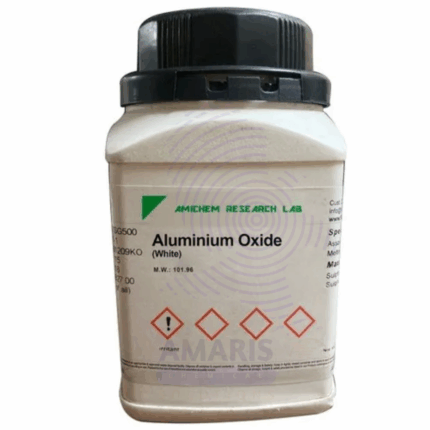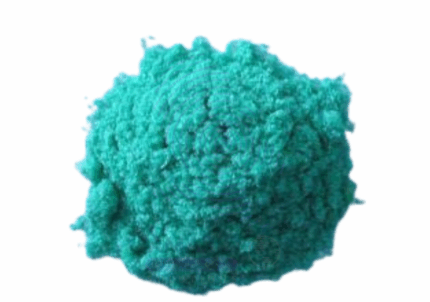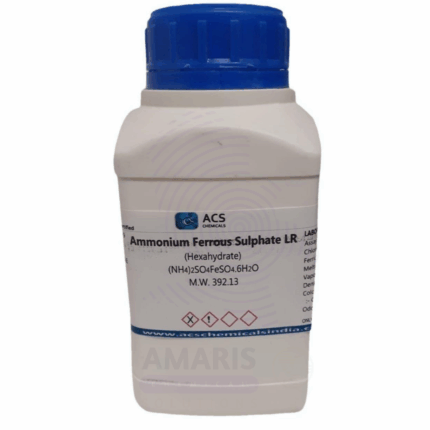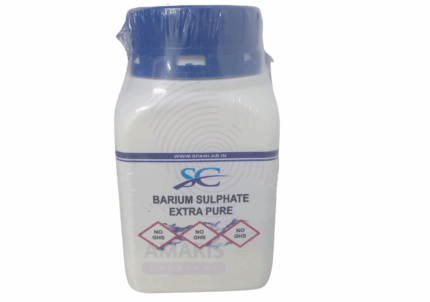
Barium Chromate Extra Pure
$ 17.00 Original price was: $ 17.00.$ 16.98Current price is: $ 16.98.
Barium Chromate Extra Pure is a high-purity, yellow crystalline powder used in laboratory chemistry for analytical, inorganic, and materials science applications. It is commonly employed in the detection of lead and other metal ions through precipitation reactions and serves as an oxidizing agent in qualitative analysis. In materials research, it is studied for its corrosion-inhibiting properties and thermal stability. Its insolubility in water and distinctive color make it useful in pigment research and educational demonstrations of double displacement and precipitation reactions. The extra pure grade ensures minimal contamination, providing reliable results in sensitive analytical work. Due to its toxicity and the presence of hexavalent chromium, it must be handled with proper safety precautions and stored in a cool, dry, well-sealed container away from incompatible substances.
Barium Chromate Extra Pure
Primary Uses
- Reagent for Lead Ion Detection
- In qualitative inorganic analysis, BaCrO₄ is used to test for Pb²⁺ — it forms a yellow precipitate of lead chromate (PbCrO₄), aiding in group analysis.
- Source of Chromate Ions in Precipitation Reactions
- Provides CrO₄²⁻ ions in double displacement and solubility experiments, especially when studying sparingly soluble salts.
- Model Compound in Solubility Product (Ksp) and Ion Exchange Studies
- Ideal for demonstrating low-solubility equilibria, common ion effect, and Ksp calculations in student labs.
- Pigment Research and Historic Pigment Replication
- Formerly used as a yellow pigment (“lemon yellow”); now studied for chemical degradation and colorfastness in conservation science.
- Demonstration of Photodecomposition and Oxidation Chemistry
- Used in studies and teaching to show chromate-based light sensitivity, decomposition, and redox behavior under various conditions.
Secondary Uses
- Reference Material in Environmental Chromium Studies
- Acts as a solid-phase source of hexavalent chromium, useful in research on Cr(VI) leaching and remediation.
- Precursor in High-Temperature Ceramic Glaze and Glass Studies
- Occasionally used in specialized labs to form colorants in glazes or optical ceramics, though less common today due to toxicity.
- Component in Corrosion-Resistant Coating Formulations (Research)
- Investigated in the lab for its role in anticorrosive primers, especially on aluminum and magnesium alloys.
- Chromium(VI) Source in Oxidation Studies
- Serves as a low-solubility oxidizing agent, releasing Cr(VI) under acidic conditions in controlled oxidation reactions.
- Teaching Tool for Chromate-Dichromate Equilibrium
- Used to illustrate acid–base equilibria and color changes when transitioning between CrO₄²⁻ (yellow) and Cr₂O₇²⁻ (orange).
| PACK SIZE |
250 grams Plastic Tin |
|---|
1. Basic Identification Attributes
- Chemical Name: Barium Chromate
- CAS Number: 10294-40-3
- HS Code: 28415090 (Other chromates of barium)
- Molecular Formula: BaCrO₄
- Synonyms:
- Barium monochromate
- Chromic acid, barium salt
- Barium yellow (used in pigments)
- Witherite chromate (mineralogical context)
2. Physical & Chemical Properties
- Physical State: Solid (fine crystalline powder)
- Color & Odor: Bright yellow; odorless
- Boiling Point: Decomposes before boiling
- Melting Point: ~210 °C (decomposes to BaO and Cr₂O₃)
- Density/Specific Gravity: ~4.5 g/cm³
- Solubility:
- Water: Slightly soluble (~0.006 g/100 mL at 20 °C)
- Acids: Soluble with evolution of toxic gases
- pH Level: Neutral to slightly alkaline in water
- Vapor Pressure: Not applicable (non-volatile)
- Flash Point: Not flammable
- Autoignition Temperature: Not applicable
- Viscosity: Not applicable
3. Safety & Hazard Attributes
- Hazard Class (GHS):
- Carcinogenicity (Category 1B)
- Mutagenicity (Category 1B)
- Reproductive Toxicity (Category 1B)
- Acute Toxicity – Oral (Category 3)
- Specific Target Organ Toxicity – Repeated Exposure (Category 1)
- Aquatic Chronic (Category 1)
- NFPA Ratings:
- Health: 4
- Flammability: 0
- Reactivity: 1
- Exposure Limits:
- OSHA PEL (as Cr VI): 5 µg/m³ (8-hr TWA)
- ACGIH TLV (as Cr VI): 0.05 mg/m³
- Reactivity:
- Reacts with acids and reducing agents
- Incompatible with organic materials, leading to fire/explosion risk
4. Storage & Handling Attributes
- Storage Conditions:
- Store in tightly sealed containers in a cool, dry, ventilated place
- Protect from light, heat, and incompatible substances
- Incompatible Materials:
- Strong acids, reducing agents, organic materials
- Container Type:
- Glass or inert plastic, clearly labeled
- Shelf Life & Expiration Date:
- ~3 years under ideal conditions
- Special Handling Requirements:
- Use gloves, goggles, lab coat, and respirator if dusty
- Handle in a fume hood only – toxic Cr(VI) dust
5. Regulatory & Compliance Attributes
- Regulatory Status:
- Listed in TSCA, REACH
- Classified as a substance of very high concern (SVHC) under REACH due to Cr(VI)
- Transportation Restrictions:
- UN Number: UN 1564 (Toxic solids, inorganic, n.o.s. – may apply depending on form and quantity)
- Hazard Class: 6.1 (Toxic), Packing Group II
- Waste Disposal Method:
- Must be treated as hazardous waste (Cr VI)
- Dispose via licensed chemical waste handler
6. Environmental & Health Impact
- Ecotoxicity:
- Extremely toxic to aquatic life (long-term effects)
- Persistence in Environment:
- Persistent and bioaccumulative due to Cr(VI) content
- Carcinogenicity/Mutagenicity:
- Known human carcinogen (IARC Group 1)
- Mutagenic and teratogenic risks present
- Biodegradability:
- Not biodegradable
SAFETY PRECAUTIONS
- Personal Protective Equipment (PPE):
- Wear a lab coat, chemical splash goggles, nitrile gloves, and a dust mask or respirator.
- Use only in a chemical fume hood—dust and fumes are hazardous.
- Handling:
- Avoid all forms of exposure: inhalation, ingestion, skin or eye contact.
- Do not mix with combustible materials—oxidizing agent.
- Prevent formation of dust. Use gentle techniques when transferring or weighing the powder.
- Storage:
- Store in a tightly sealed container in a cool, dry, well-ventilated place.
- Keep away from reducing agents, organic materials, acids, and heat.
- Label clearly as Toxic, Carcinogenic, and Oxidizing.
- Hygiene Measures:
- Wash hands and face thoroughly after handling.
- Do not eat, drink, or smoke in the lab.
- Decontaminate surfaces after use with a suitable chromium-specific deactivating agent.
FIRST AID MEASURES
- Inhalation:
- Remove to fresh air immediately.
- Administer oxygen if breathing is difficult.
- Seek urgent medical attention—can cause respiratory tract irritation, lung damage, or chromium toxicity.
- Skin Contact:
- Wash skin thoroughly with soap and water.
- Remove contaminated clothing and isolate it.
- Seek medical attention—absorption through skin is possible and chromates are corrosive and sensitizing.
- Eye Contact:
- Rinse with plenty of water for at least 15 minutes, lifting eyelids.
- Seek immediate medical attention—can cause serious eye damage.
- Ingestion:
- Do NOT induce vomiting.
- Rinse mouth thoroughly with water.
- Give water or milk only if the person is fully conscious.
- Seek emergency medical attention—barium and chromium compounds are both highly toxic.
FIRE FIGHTING MEASURES
- Extinguishing Media:
- Use dry chemical, CO₂, or foam. Water spray may be used cautiously.
- Specific Fire Hazards:
- Not combustible itself, but acts as a strong oxidizer and enhances combustion of other materials.
- Heating may release toxic fumes, including:
- Chromium(VI) compounds
- Barium oxide
- Oxygen (accelerates fire)
- Protective Equipment:
- Firefighters should wear SCBA (self-contained breathing apparatus) and full chemical protective clothing.
- Firefighting Instructions:
- Approach from upwind.
- Cool unopened containers with water spray.
- Prevent runoff from entering drains—extremely toxic to aquatic life.


 Preservatives(food)
Preservatives(food) Flavor Enhancers
Flavor Enhancers Acidulants
Acidulants Sweeteners
Sweeteners Antioxidants
Antioxidants Colorants(food)
Colorants(food) Nutraceutical Ingredients (food)
Nutraceutical Ingredients (food) Nutrient Supplements
Nutrient Supplements Emulsifiers
Emulsifiers
 Collectors
Collectors Dust Suppressants
Dust Suppressants Explosives and Blasting Agents
Explosives and Blasting Agents Flocculants and Coagulants
Flocculants and Coagulants Frothers
Frothers Leaching Agents
Leaching Agents pH Modifiers
pH Modifiers Precious Metal Extraction Agents
Precious Metal Extraction Agents
 Antioxidants(plastic)
Antioxidants(plastic) Colorants (Pigments, Dyes)
Colorants (Pigments, Dyes) Fillers and Reinforcements
Fillers and Reinforcements Flame Retardants
Flame Retardants Monomers
Monomers Plasticizers
Plasticizers Polymerization Initiators
Polymerization Initiators Stabilizers (UV, Heat)
Stabilizers (UV, Heat)
 Antifoaming Agents
Antifoaming Agents Chelating Agents
Chelating Agents Coagulants and Flocculants
Coagulants and Flocculants Corrosion Inhibitors
Corrosion Inhibitors Disinfectants and Biocides
Disinfectants and Biocides Oxidizing Agents
Oxidizing Agents pH Adjusters
pH Adjusters Scale Inhibitors( water)
Scale Inhibitors( water)
 Antioxidants(cosmetic)
Antioxidants(cosmetic) Emollients
Emollients Fragrances and Essential Oils
Fragrances and Essential Oils Humectants
Humectants Preservatives
Preservatives Surfactants(cosmetic)
Surfactants(cosmetic) Thickeners
Thickeners UV Filters
UV Filters
 Fertilizers
Fertilizers Soil Conditioners
Soil Conditioners Plant Growth Regulators
Plant Growth Regulators Animal Feed Additives
Animal Feed Additives Biostimulants
Biostimulants Pesticides (Herbicides, Insecticides, Fungicides)
Pesticides (Herbicides, Insecticides, Fungicides)
 Active Pharmaceutical Ingredients (APIs)
Active Pharmaceutical Ingredients (APIs) Excipients
Excipients Solvents(pharmaceutical)
Solvents(pharmaceutical) Antibiotics
Antibiotics Antiseptics and Disinfectants
Antiseptics and Disinfectants Vaccine Adjuvants
Vaccine Adjuvants Nutraceutical Ingredients (pharmaceutical)
Nutraceutical Ingredients (pharmaceutical) Analgesics & Antipyretics
Analgesics & Antipyretics
 Analytical Reagents
Analytical Reagents Solvents(lab)
Solvents(lab) Chromatography Chemicals
Chromatography Chemicals Spectroscopy Reagents
Spectroscopy Reagents microbiology-and-cell-culture-reagents
microbiology-and-cell-culture-reagents Molecular Biology Reagents
Molecular Biology Reagents Biochemical Reagents
Biochemical Reagents Inorganic and Organic Standards
Inorganic and Organic Standards Laboratory Safety Chemicals
Laboratory Safety Chemicals Specialty Laboratory Chemicals(Special Laboratory Equipment)
Specialty Laboratory Chemicals(Special Laboratory Equipment)
 Demulsifiers
Demulsifiers Hydraulic Fracturing Fluids
Hydraulic Fracturing Fluids Scale Inhibitors(oil)
Scale Inhibitors(oil) Surfactants(oil)
Surfactants(oil) Drilling Fluids
Drilling Fluids
 Dyes and Pigments
Dyes and Pigments Bleaching Agents
Bleaching Agents Softening Agents
Softening Agents Finishing Agents
Finishing Agents Antistatic Agents
Antistatic Agents
 Admixtures
Admixtures Waterproofing Agents
Waterproofing Agents Sealants and Adhesives
Sealants and Adhesives Curing Compounds
Curing Compounds Concrete Repair Chemicals
Concrete Repair Chemicals Anti-Corrosion Coatings
Anti-Corrosion Coatings
 Surfactants(cleaning)
Surfactants(cleaning) Builders
Builders Enzymes
Enzymes Solvents (Cleaning)
Solvents (Cleaning) Fragrances
Fragrances
 Electronic Chemicals
Electronic Chemicals Catalysts
Catalysts Lubricants
Lubricants Photographic Chemicals
Photographic Chemicals Refrigerants
Refrigerants Automotive chemicals
Automotive chemicals Pyrotechnic Chemicals
Pyrotechnic Chemicals
 Biodegradable Surfactants
Biodegradable Surfactants Bio-based Solvents
Bio-based Solvents Renewable Polymers
Renewable Polymers Carbon Capture Chemicals
Carbon Capture Chemicals Wastewater Treatment Chemicals
Wastewater Treatment Chemicals
 Pigments
Pigments Solvents(paint)
Solvents(paint) Specialty Coatings
Specialty Coatings Binders/Resins
Binders/Resins Additives
Additives Driers
Driers Anti-Corrosion Agents
Anti-Corrosion Agents Functional Coatings
Functional Coatings Application-Specific Coatings
Application-Specific Coatings
 Fresh Herbs
Fresh Herbs Ground Spices
Ground Spices Whole Spices
Whole Spices Spice Blends
Spice Blends Dried Herbs
Dried Herbs
 Leavening Agents
Leavening Agents Dough Conditioners
Dough Conditioners Flour Treatments
Flour Treatments Fat Replacers
Fat Replacers Decoratives
Decoratives Preservatives(baking)
Preservatives(baking)
 Plasticizers & Softeners
Plasticizers & Softeners Reinforcing Agents
Reinforcing Agents Adhesion Promoters
Adhesion Promoters Vulcanizing Agents
Vulcanizing Agents Antidegradants
Antidegradants Blowing Agents
Blowing Agents Fillers & Extenders
Fillers & Extenders Accelerators & Retarders
Accelerators & Retarders